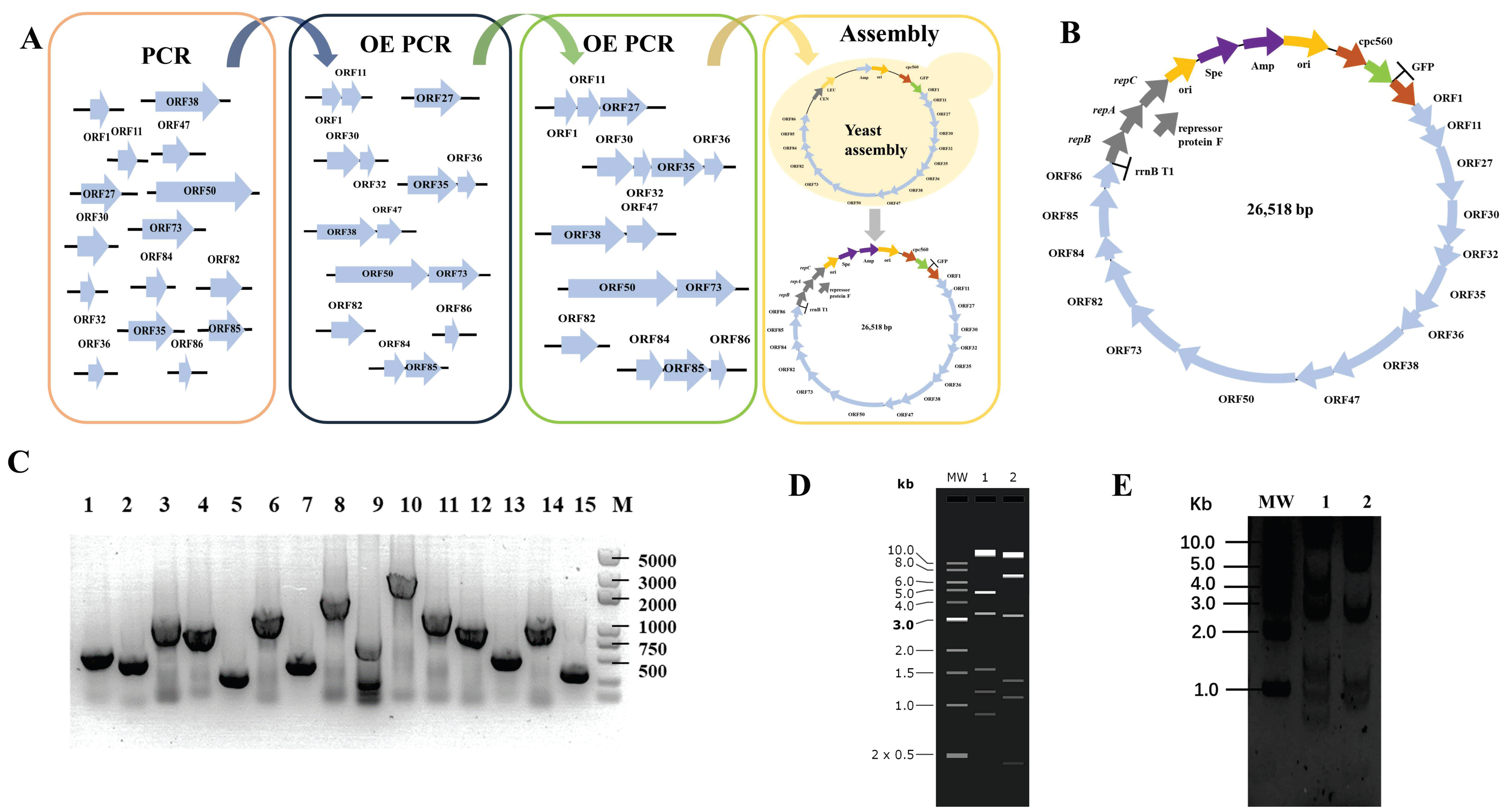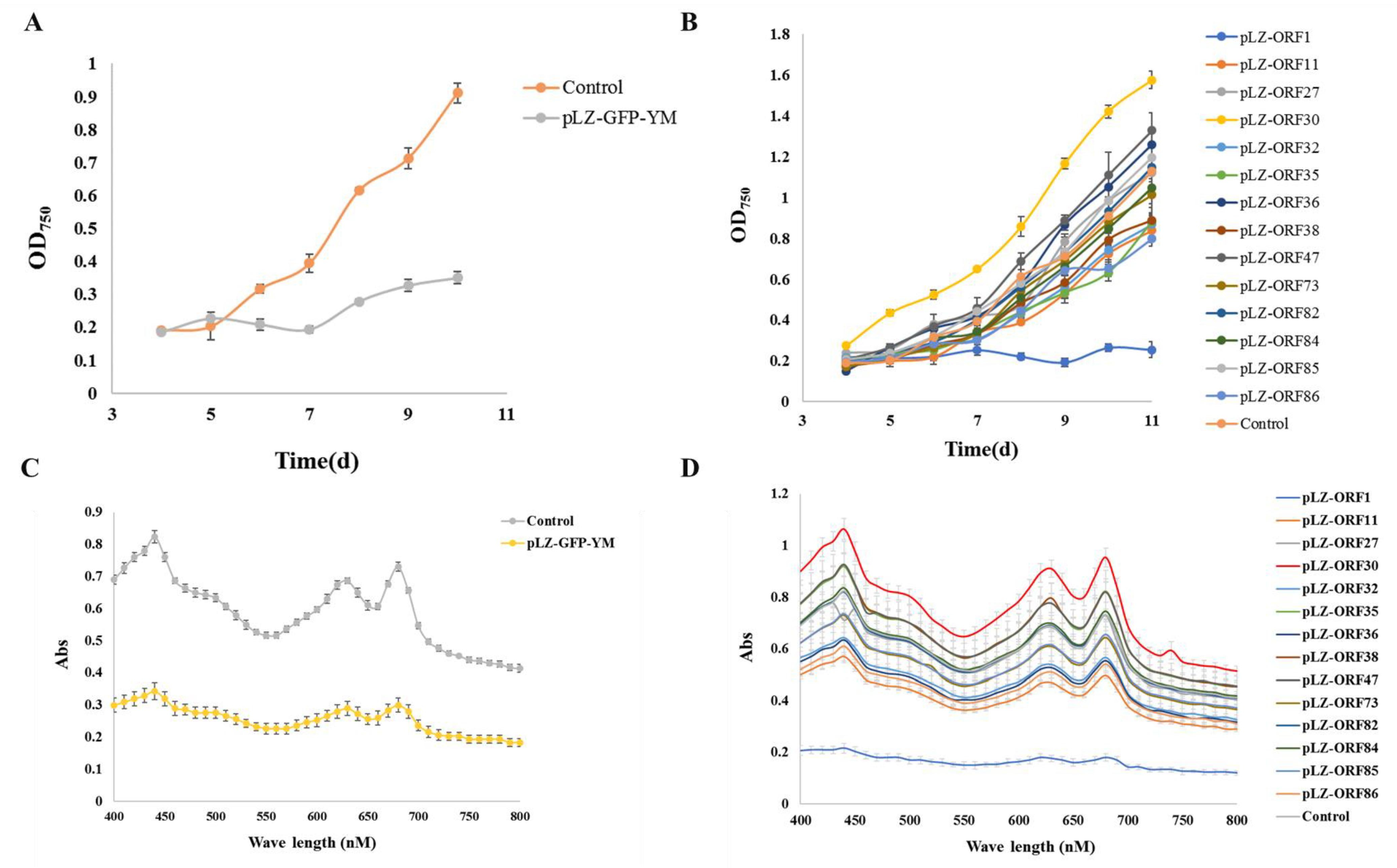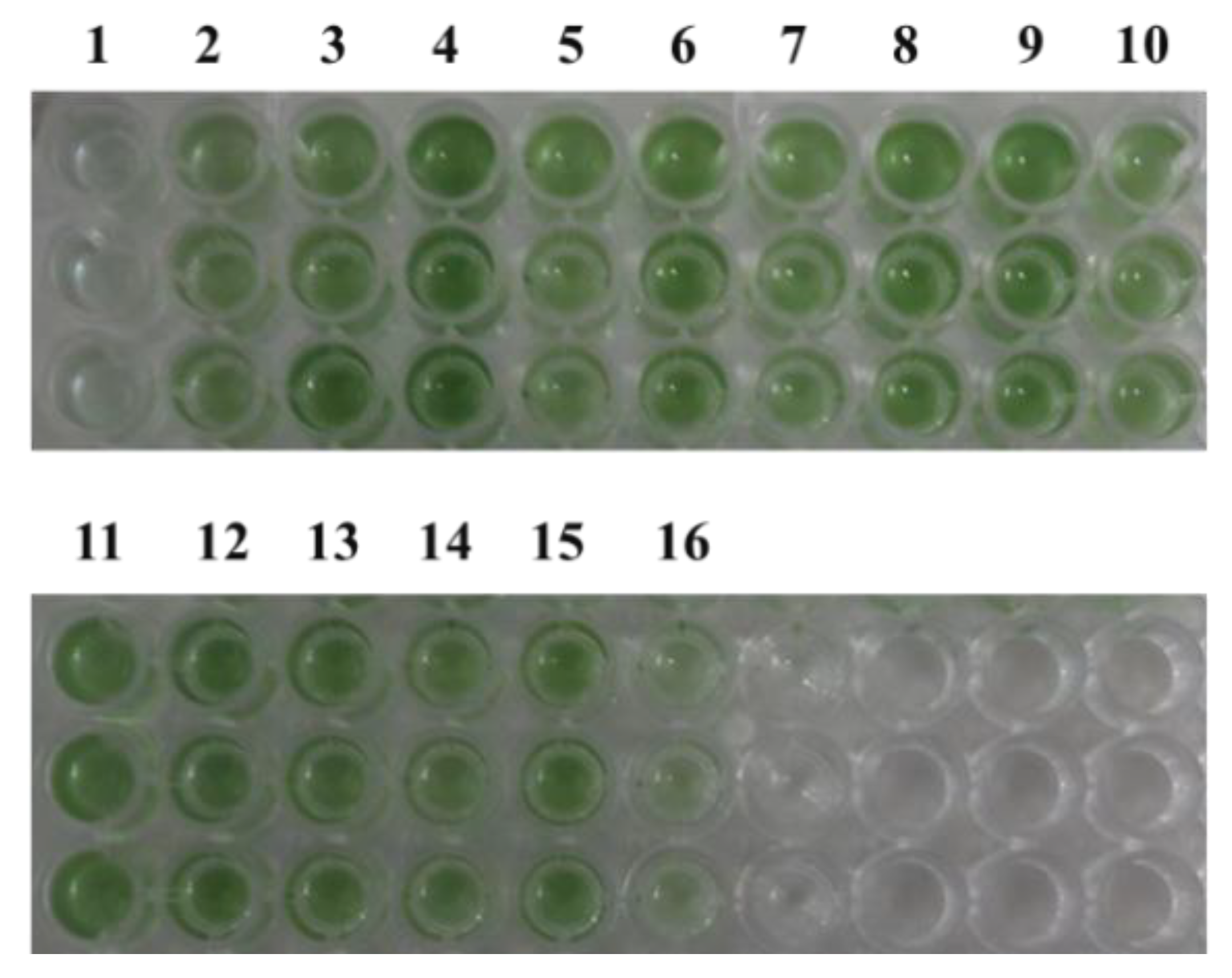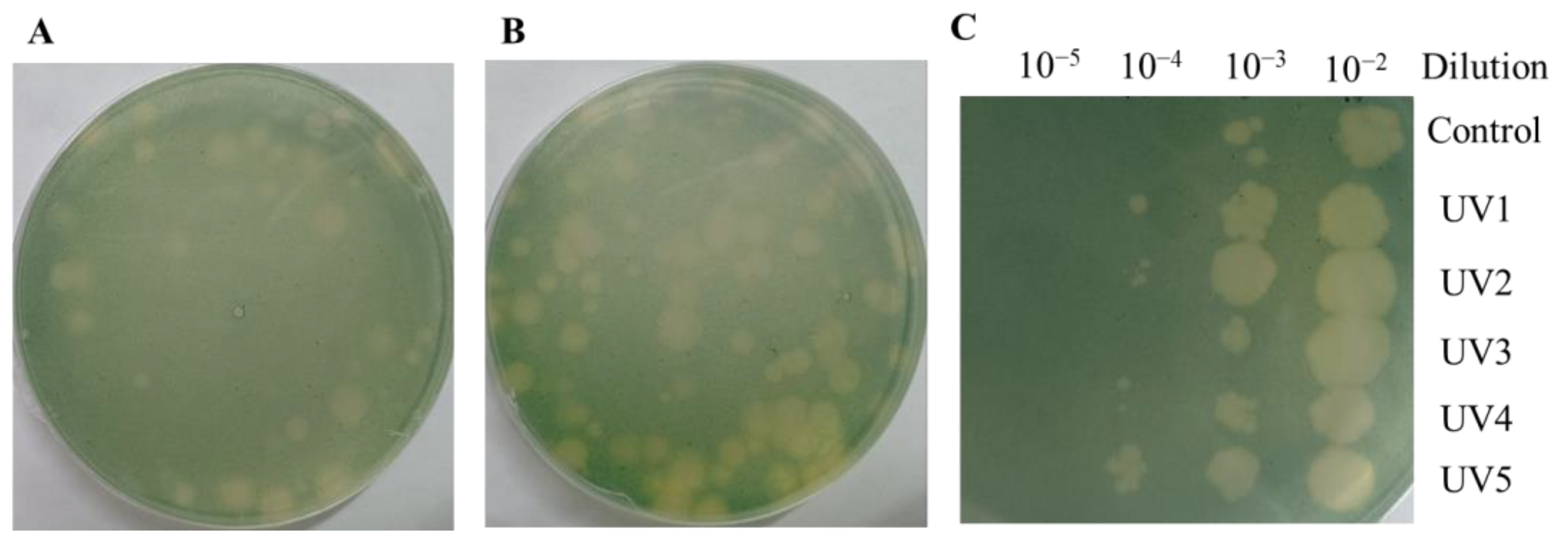Efficient Broad-Spectrum Cyanophage Function Module Mining
Abstract
:1. Introduction
2. Material and Methods
2.1. Strains, Plasmids, and Culture Conditions
2.2. Minimal Genome Assembly
2.3. In Vitro Assembly
2.4. Transformation of Cyanobacteria
2.5. Growth Curve
2.6. Mutation Condition
2.7. Growth and Stability
2.8. Genome Enrichment and Extraction
3. Results
3.1. YongM Essential Gene Analysis
3.2. De Novo Construct Minimum Artificial Cyanophage
3.3. Effects of Salt Stress on Artificial Cyanophage
3.4. Isolation and Stability Tests of Mutant Cyanophages
3.5. Analysis of Mutation Site Distribution in Mutant Genome
4. Conclusions and Discussions
Supplementary Materials
Author Contributions
Funding
Data Availability Statement
Acknowledgments
Conflicts of Interest
References
- Aranda, Y.N.; Bhatt, P.; Ates, N.; Engel, B.A.; Simsek, H. Cyanophage-cyanobacterial interactions for sustainable aquatic environment. Environ. Res. 2023, 229, 115728. [Google Scholar] [CrossRef] [PubMed]
- Paerl, H.W.; Fulton, R.S., 3rd; Moisander, P.H.; Dyble, J. Harmful freshwater algal blooms, with an emphasis on cyanobacteria. Sci. World J. 2001, 1, 76–113. [Google Scholar] [CrossRef] [PubMed]
- Elliott, J.A. Is the future blue-green? A review of the current model predictions of how climate change could affect pelagic freshwater cyanobacteria. Water Res. 2012, 46, 1364–1371. [Google Scholar] [CrossRef] [PubMed]
- Bhatt, P.; Engel, B.A.; Reuhs, M.; Simsek, H. Cyanophage technology in removal of cyanobacteria mediated harmful algal blooms: A novel and eco-friendly method. Chemosphere 2023, 315, 137769. [Google Scholar] [CrossRef] [PubMed]
- Zhu, X.; Li, Z.; Tong, Y.; Chen, L.; Sun, T.; Zhang, W. From natural to artificial cyanophages: Current progress and application prospects. Environ. Res. 2023, 223, 115428. [Google Scholar] [CrossRef] [PubMed]
- Lin, W.; Li, D.; Sun, Z.; Tong, Y.; Yan, X.; Wang, C.; Zhang, X.; Pei, G. A novel freshwater cyanophage vB_MelS-Me-ZS1 infecting bloom-forming cyanobacterium Microcystis elabens. Mol. Biol. Rep. 2020, 47, 7979–7989. [Google Scholar] [CrossRef] [PubMed]
- Qin, W.; Li, D.; Xu, L.; Lin, W.; Tong, Y. Complete genome analysis of an active prophage of Vibrio alginolyticus. Arch. Virol. 2021, 166, 891–896. [Google Scholar] [CrossRef] [PubMed]
- Yang, F.; Jiang, Y.L.; Zhang, J.T.; Zhu, J.; Du, K.; Yu, R.C.; Wei, Z.L.; Kong, W.W.; Cui, N.; Li, W.F.; et al. Fine structure and assembly pattern of a minimal myophage Pam3. Proc. Natl. Acad. Sci. USA 2023, 120, e2213727120. [Google Scholar] [CrossRef]
- Zhang, S.; Zhao, B.; Li, J.; Song, X.; Tong, Y.; An, W. Host Cyanobacteria Killing by Novel Lytic Cyanophage YongM: A Protein Profiling Analysis. Microorganisms 2022, 10, 257. [Google Scholar] [CrossRef]
- Liu, S.; Feng, J.; Sun, T.; Xu, B.; Zhang, J.; Li, G.; Zhou, J.; Jiang, J. The Synthesis and Assembly of a Truncated Cyanophage Genome and Its Expression in a Heterogenous Host. Life 2022, 12, 1234. [Google Scholar] [CrossRef]
- Chen, Y.; Ge, P.; Sun, T.; Feng, J.; Li, G.; Zhang, J.; Zhou, J.; Jiang, J. Coexpression of Tail Fiber and Tail Protein Genes of the Cyanophage PP Using a Synthetic Genomics Approach Enhances the Salt Tolerance of Synechocystis PCC 6803. Microbiol. Spectr. 2023, 11, e0500922. [Google Scholar] [CrossRef] [PubMed]
- Meistrich, M.L.; Shulman, R.G. Mutagenic effect of sensitized irradiation of bacteriophage T4. J. Mol. Biol. 1969, 46, 157–167. [Google Scholar] [CrossRef] [PubMed]
- Drake, J.W. Ultraviolet mutagenesis in bacteriophage T-4. I. Irradiation of extracellular phage particles. J. Bacteriol. 1966, 91, 1775–1780. [Google Scholar] [CrossRef]
- Bhattarai, S.R.; Yoo, S.Y.; Lee, S.W.; Dean, D. Engineered phage-based therapeutic materials inhibit Chlamydia trachomatis intracellular infection. Biomaterials 2012, 33, 5166–5174. [Google Scholar] [CrossRef] [PubMed]
- Krom, R.J.; Bhargava, P.; Lobritz, M.A.; Collins, J.J. Engineered Phagemids for Nonlytic, Targeted Antibacterial Therapies. Nano Lett. 2015, 15, 4808–4813. [Google Scholar] [CrossRef] [PubMed]
- Marinelli, L.J.; Piuri, M.; Swigonová, Z.; Balachandran, A.; Oldfield, L.M.; van Kessel, J.C.; Hatfull, G.F. BRED: A simple and powerful tool for constructing mutant and recombinant bacteriophage genomes. PLoS ONE 2008, 3, e3957. [Google Scholar] [CrossRef] [PubMed]
- Marinelli, L.J.; Piuri, M.; Hatfull, G.F. Genetic Manipulation of Lytic Bacteriophages with BRED: Bacteriophage Recombineering of Electroporated DNA. Methods Mol. Biol. 2019, 1898, 69–80. [Google Scholar] [CrossRef] [PubMed]
- Martel, B.; Moineau, S. CRISPR-Cas: An efficient tool for genome engineering of virulent bacteriophages. Nucleic Acids Res. 2014, 42, 9504–9513. [Google Scholar] [CrossRef] [PubMed]
- Pryor, J.M.; Potapov, V.; Bilotti, K.; Pokhrel, N.; Lohman, G.J.S. Rapid 40 kb Genome Construction from 52 Parts through Data-optimized Assembly Design. ACS Synth. Biol. 2022, 11, 2036–2042. [Google Scholar] [CrossRef]
- Favor, A.H.; Llanos, C.D.; Youngblut, M.D.; Bardales, J.A. Optimizing bacteriophage engineering through an accelerated evolution platform. Sci. Rep. 2020, 10, 13981. [Google Scholar] [CrossRef]
- Shitrit, D.; Hackl, T.; Laurenceau, R.; Raho, N.; Carlson, M.C.G.; Sabehi, G.; Schwartz, D.A.; Chisholm, S.W.; Lindell, D. Genetic engineering of marine cyanophages reveals integration but not lysogeny in T7-like cyanophages. ISME J. 2022, 16, 488–499. [Google Scholar] [CrossRef] [PubMed]
- Kirsch, F.; Klähn, S.; Hagemann, M. Salt-Regulated Accumulation of the Compatible Solutes Sucrose and Glucosylglycerol in Cyanobacteria and Its Biotechnological Potential. Front. Microbiol. 2019, 10, 2139. [Google Scholar] [CrossRef] [PubMed]
- Liang, Y.; Zhang, M.; Wang, M.; Zhang, W.; Qiao, C.; Luo, Q.; Lu, X. Freshwater Cyanobacterium Synechococcus elongatus PCC 7942 Adapts to an Environment with Salt Stress via Ion-Induced Enzymatic Balance of Compatible Solutes. Appl. Environ. Microbiol. 2020, 86, e02904-19. [Google Scholar] [CrossRef] [PubMed]
- Cui, Q.; Shin, W.S.; Luo, Y.; Tian, J.; Cui, H.; Yin, D. Thymidylate kinase: An old topic brings new perspectives. Curr. Med. Chem. 2013, 20, 1286–1305. [Google Scholar] [CrossRef] [PubMed]
- Daugelavičius, R.; Daujotaitė, G.; Bamford, D.H. Lysis Physiology of Pseudomonas aeruginosa Infected with ssRNA Phage PRR1. Viruses 2024, 16, 645. [Google Scholar] [CrossRef] [PubMed]
- Macdonald Miller, S.; Abbriano, R.M.; Herdean, A.; Banati, R.; Ralph, P.J.; Pernice, M. Random mutagenesis of Phaeodactylum tricornutum using ultraviolet, chemical, and X-radiation demonstrates the need for temporal analysis of phenotype stability. Sci. Rep. 2023, 13, 22385. [Google Scholar] [CrossRef] [PubMed]
- Cheng, L.; Zhao, S.; Li, T.; Hou, S.; Luo, Z.; Xu, J.; Yu, W.; Jiang, S.; Monti, M.; Schindler, D.; et al. Large-scale genomic rearrangements boost SCRaMbLE in Saccharomyces cerevisiae. Nat. Commun. 2024, 15, 770. [Google Scholar] [CrossRef] [PubMed]
- Esvelt, K.M.; Carlson, J.C.; Liu, D.R. A system for the continuous directed evolution of biomolecules. Nature 2011, 472, 499–503. [Google Scholar] [CrossRef]
- Sun, L.; Zhang, Q.; Kong, X.; Liu, Y.; Li, J.; Du, G.; Lv, X.; Ledesma-Amaro, R.; Chen, J.; Liu, L. Highly efficient neutralizer-free l-malic acid production using engineered Saccharomyces cerevisiae. Bioresour. Technol. 2023, 370, 128580. [Google Scholar] [CrossRef]
- Lennen, R.M.; Lim, H.G.; Jensen, K.; Mohammed, E.T.; Phaneuf, P.V.; Noh, M.H.; Malla, S.; Börner, R.A.; Chekina, K.; Özdemir, E.; et al. Laboratory evolution reveals general and specific tolerance mechanisms for commodity chemicals. Metab. Eng. 2023, 76, 179–192. [Google Scholar] [CrossRef]
- Grasso, C.R.; Pokrzywinski, K.L.; Waechter, C.; Rycroft, T.; Zhang, Y.; Aligata, A.; Kramer, M.; Lamsal, A. A Review of Cyanophage-Host Relationships: Highlighting Cyanophages as a Potential Cyanobacteria Control Strategy. Toxins 2022, 14, 385. [Google Scholar] [CrossRef] [PubMed]
- Dekel-Bird, N.P.; Sabehi, G.; Mosevitzky, B.; Lindell, D. Host-dependent differences in abundance, composition and host range of cyanophages from the Red Sea. Environ. Microbiol. 2015, 17, 1286–1299. [Google Scholar] [CrossRef] [PubMed]
- Zhang, T.; Xu, B.; Feng, J.; Ge, P.; Li, G.; Zhang, J.; Zhou, J.; Jiang, J. Synthesis and assembly of full-length cyanophage A-4L genome. Synth. Syst. Biotechnol. 2023, 8, 121–128. [Google Scholar] [CrossRef] [PubMed]
- Yu, R.C.; Yang, F.; Zhang, H.Y.; Hou, P.; Du, K.; Zhu, J.; Cui, N.; Xu, X.; Chen, Y.; Li, Q.; et al. Structure of the intact tail machine of Anabaena myophage A-1(L). Nat. Commun. 2024, 15, 2654. [Google Scholar] [CrossRef] [PubMed]






| ORF | Start Site | End Site | Length | Predictive Function |
|---|---|---|---|---|
| ORF1 | 4603 | 5247 | 645 | Thymidyate kinase |
| ORF11 | 6301 | 6807 | 507 | capsid fiber protein |
| ORF27 | 13,086 | 14,444 | 1359 | Large subunit terminase |
| ORF30 | 14,445 | 15,542 | 1098 | the major capsid protein |
| ORF32 | 15,543 | 15,869 | 327 | putative tail-component |
| ORF35 | 15,870 | 17,390 | 1521 | Tail connector protein |
| ORF36 | 17,391 | 17,900 | 510 | Tail connector protein |
| ORF38 | 17,901 | 19,967 | 2067 | Tail-Associated Protein |
| ORF47 | 22,671 | 23,555 | 885 | DNA polymerase III subunit alpha |
| ORF50 | 23,556 | 26,645 | 3090 | primase |
| ORF73 | 27,510 | 29,081 | 1572 | DNA translocase FTSK |
| ORF82 | 32,499 | 33,632 | 1134 | Phage Tail Collar Domain |
| ORF84 | 33,633 | 34,208 | 576 | Phage tail protein |
| ORF85 | 34,209 | 35,383 | 1176 | Baseplate wedge protein gp7 |
| ORF86 | 35,384 | 35,731 | 348 | lysozyme |
| Strain | ORF | Mutation Site (bp) | Codon Mutate | AA Mutate | Predictive Function |
|---|---|---|---|---|---|
| UV1 | ORF83 | 59,382 | GCT <-> GTT | A <-> V | Phage-related tail fiber protein |
| UV2 | ORF83 | 58,773 | GGA <-> GAA | G <-> E | Phage-related tail fiber protein |
| UV3 | ORF12 | 6196 | Delete A | Alkaline phosphatase D | |
| UV3 | ORF83 | 59,382 | GCT <-> GTT | A <-> V | Phage-related tail fiber protein |
| UV3 | ORF90 | 63,358 | Synonymous mutation | ||
| UV4 | ORF83 | 59,382 | GCT <-> GTT | A <-> V | Phage-related tail fiber protein |
| UV5 | ORF83 | 58,773 | GGA <-> GAA | G <-> E | Phage-related tail fiber protein |
Disclaimer/Publisher’s Note: The statements, opinions and data contained in all publications are solely those of the individual author(s) and contributor(s) and not of MDPI and/or the editor(s). MDPI and/or the editor(s) disclaim responsibility for any injury to people or property resulting from any ideas, methods, instructions or products referred to in the content. |
© 2024 by the authors. Licensee MDPI, Basel, Switzerland. This article is an open access article distributed under the terms and conditions of the Creative Commons Attribution (CC BY) license (https://creativecommons.org/licenses/by/4.0/).
Share and Cite
Guo, Y.; Dong, X.; Li, H.; Lin, W.; Cao, L.; Li, D.; Zhang, Y.; Jin, J.; Tong, Y.; Liu, Z. Efficient Broad-Spectrum Cyanophage Function Module Mining. Microorganisms 2024, 12, 1578. https://doi.org/10.3390/microorganisms12081578
Guo Y, Dong X, Li H, Lin W, Cao L, Li D, Zhang Y, Jin J, Tong Y, Liu Z. Efficient Broad-Spectrum Cyanophage Function Module Mining. Microorganisms. 2024; 12(8):1578. https://doi.org/10.3390/microorganisms12081578
Chicago/Turabian StyleGuo, Yujing, Xiaoxiao Dong, Huiying Li, Wei Lin, Lei Cao, Dengfeng Li, Yiming Zhang, Jin Jin, Yigang Tong, and Zihe Liu. 2024. "Efficient Broad-Spectrum Cyanophage Function Module Mining" Microorganisms 12, no. 8: 1578. https://doi.org/10.3390/microorganisms12081578







